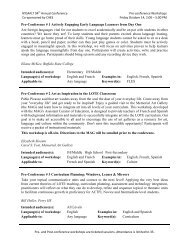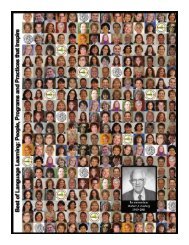THE COMPLETE CURRICULUM Ensuring a Place for the Arts and ...
THE COMPLETE CURRICULUM Ensuring a Place for the Arts and ...
THE COMPLETE CURRICULUM Ensuring a Place for the Arts and ...
- No tags were found...
You also want an ePaper? Increase the reach of your titles
YUMPU automatically turns print PDFs into web optimized ePapers that Google loves.
NASBE<strong>THE</strong> <strong>COMPLETE</strong> <strong>CURRICULUM</strong>state policymakers have an opportunityto set requirements <strong>for</strong> teachersof <strong>the</strong> arts <strong>and</strong> <strong>for</strong>eign languages thatwill ensure high-quality instruction.Several national organizations thatfocus on teacher licensing, such as <strong>the</strong>National Board <strong>for</strong> ProfessionalTeaching St<strong>and</strong>ards (NBPTS), <strong>the</strong>Interstate New Teacher Assessment<strong>and</strong> Support Consortium (INTASC),<strong>and</strong> <strong>the</strong> National Council <strong>for</strong> Accreditationof Teacher Education(NCATE) have done a great deal ofwork in both <strong>the</strong> arts <strong>and</strong> <strong>for</strong>eignlanguages to develop st<strong>and</strong>ards <strong>for</strong>teachers that are aligned with nationalst<strong>and</strong>ards <strong>for</strong> students. Theseorganizations have developedresources, with input from nationalassociations, that states can use inei<strong>the</strong>r developing or reviewinglicensure requirements <strong>for</strong> <strong>the</strong> arts<strong>and</strong> <strong>for</strong>eign languages.States should establish separatelicensure areas <strong>for</strong> each of <strong>the</strong> K-12 artsdisciplines <strong>and</strong> <strong>for</strong> <strong>for</strong>eign languageinstructors. For example, few stateseven have basic licensing requirements<strong>for</strong> dance <strong>and</strong> <strong>the</strong>ater. States shouldalso establish alternative routes <strong>for</strong>individuals with language skills or <strong>for</strong>artists. Higher education institutionsshould be included in <strong>the</strong> review oflicensure requirements to ensureimplementation of <strong>the</strong> requirements<strong>for</strong> preparation <strong>and</strong> licensure. Inaddition, states should incorporate <strong>the</strong>arts <strong>and</strong> <strong>for</strong>eign languages intolicensure requirements <strong>for</strong> administrators.Many decisions about curriculumhappen at <strong>the</strong> local level, <strong>and</strong> havingleaders that underst<strong>and</strong> <strong>the</strong> importanceof <strong>the</strong> arts <strong>and</strong> <strong>for</strong>eign languages is crucialto <strong>the</strong>ir survival in <strong>the</strong> curriculum.States should also examinerecruitment policies <strong>and</strong> practices <strong>for</strong>teachers. One state that has achievedsome success in adopting <strong>and</strong>implementing a policy <strong>for</strong> <strong>for</strong>eignlanguage teachers is Louisiana.Bulletin 741 m<strong>and</strong>ates <strong>for</strong>eignlanguage instruction <strong>for</strong> all academicallyable students in grades 4-8, withinstruction being optional <strong>for</strong> all o<strong>the</strong>rstudents. The classes <strong>for</strong> grades 4-6must meet <strong>for</strong> a minimum of 30minutes daily <strong>for</strong> <strong>the</strong> entire schoolyear, <strong>and</strong> <strong>for</strong> grades 7-8 <strong>the</strong> requirementis150 minutes per week. Onestep <strong>the</strong> state has taken to ensure thatschools are able to comply with <strong>the</strong>m<strong>and</strong>ate is to focus on <strong>the</strong> supply ofqualified teachers—often a challengeregardless of <strong>the</strong> content area. Toaddress <strong>the</strong> issue, <strong>the</strong> state hasnegotiated agreements with <strong>for</strong>eigngovernments <strong>for</strong> teacher exchanges tohelp schools sustain <strong>the</strong> program.States can also encourage studyabroadprograms <strong>for</strong> teachers.Recommendation 2: Ensureadequate time <strong>for</strong> high-qualityprofessional development <strong>for</strong> staffin <strong>the</strong> arts <strong>and</strong> <strong>for</strong>eign languages.State education officials shouldalso help to establish relationshipsbetween local school districts <strong>and</strong>universities in order to provide arts<strong>and</strong> language teachers with anadequate system <strong>for</strong> professionaldevelopment. For <strong>the</strong> arts, manypeople within artistic communitiesacross <strong>the</strong> nation aid teachers <strong>and</strong>consider <strong>the</strong>ir professional developmenta top priority; however, <strong>the</strong>re isstill much that state policymakers c<strong>and</strong>o. Data show that hardly any statesrequire professional developmentthat specifically focuses on <strong>the</strong> arts or<strong>for</strong>eign languages. State policymakersmust ensure that adequate time,adequate funding, <strong>and</strong> adequateopportunities are available <strong>for</strong> highqualityprofessional development <strong>for</strong>arts <strong>and</strong> <strong>for</strong>eign language instructors.Recommendation 3: Ensureadequate staff expertise at <strong>the</strong> stateeducation agency to work in <strong>the</strong>areas of <strong>the</strong> arts <strong>and</strong> <strong>for</strong>eignlanguages.Ano<strong>the</strong>r component of ef<strong>for</strong>ts toensure strong arts <strong>and</strong> languageprograms that easily falls to <strong>the</strong>wayside in times of fiscal belttighteningis <strong>the</strong> number of individualsin <strong>the</strong> state education agency whoMaryl<strong>and</strong>’s <strong>Arts</strong> Education PolicyOne state that has successfully implemented arts education statewide isMaryl<strong>and</strong>. In 1989, Maryl<strong>and</strong> enacted a policy to require fine arts credit <strong>for</strong>graduation. Over <strong>the</strong> next several years, constituency groups worked toge<strong>the</strong>r tocreate a movement at <strong>the</strong> state level <strong>for</strong> arts education. In 1995, <strong>the</strong> Maryl<strong>and</strong>State Board of Education adopted <strong>the</strong> Schools <strong>for</strong> Success Goal that by <strong>the</strong> year2000, 100 percent of Maryl<strong>and</strong>’s students would be participating in fine artsprograms that would enable <strong>the</strong>m to achieve state st<strong>and</strong>ards in <strong>the</strong> arts. Theboard requires “each school system to provide an instructional program in...finearts each year <strong>for</strong> all students in grades K-8.” In addition, several task <strong>for</strong>ces onarts education were <strong>for</strong>med throughout <strong>the</strong> mid-1990s to develop content <strong>and</strong>achievement st<strong>and</strong>ards <strong>for</strong> students. The state is also working to develop options<strong>for</strong> measuring student achievement in <strong>the</strong> arts.18






